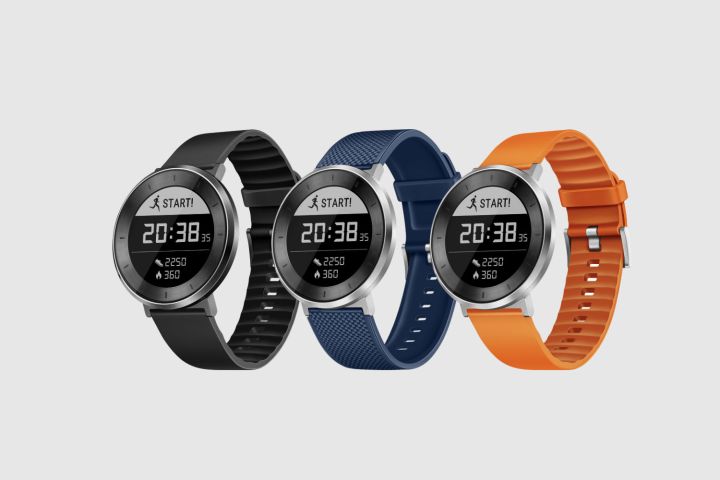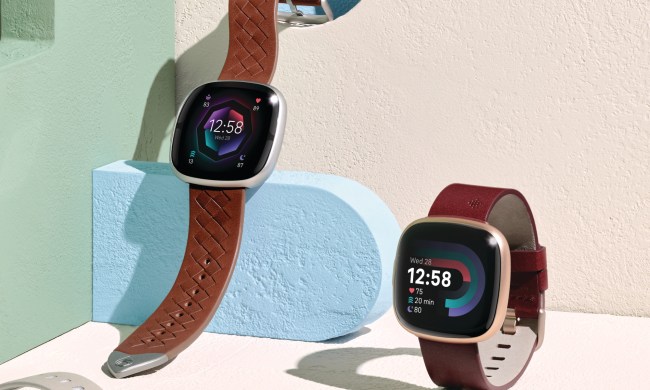
The Huawei Fit is akin to Fitbit’s Charge 2 band — it features a continuous heart-rate monitor, can track various exercises but has a focus on running, monitors your daily activity, pairs with your smartphone to alert you of incoming calls and messages, and monitors your sleep.
But while the Charge 2 costs $150, Huawei undercuts the tracker with a $130 price tag. It also has a leg up with two important features: longer battery life and water resistance up to 50 meters.
The Huawei Fit has an 80mAh battery that offers up to six days with “normal use,” but thanks to its memory LCD touchscreen (similar to the Pebble), it can last up to 30 days in standby mode. A memory LCD touchscreen is like a harmony between an e-ink display and an LCD. You’ll also notice the always-on screen only displays content in black or white, which also helps with conserving battery.
Design wise, there’s nothing too special about Huawei’s 39.5mm watch. It has a sizable bezel around the display, which is housed in an aluminum case. An ambient sensor will help you check the screen easily in broad daylight. The silicone band comes in an 18mm or 20mm size and is interchangeable. It comes in three color variants — black, blue, and orange — but you also have the option to choose the color of the metal casing: “Moonlight Silver or Titanium Grey.”
The Huawei Fit isn’t a smartwatch.
With the Fit on, it can detect when you’re running, walking, or sleeping, so you don’t need to trigger a session. It tracks basic fitness information like most devices in its category including steps, distance, calories burned, and duration of sleep. You can set goals via the Huawei app for more personal measurements, and after any exercise session, it will show you relevant information, including your VO2 max and your exercise result score.
Running is one of the core focuses of the Fit — Huawei says it partnered with FirstBeat, a fitness analytics company, to help users “design running plans,” get real-time guidance during exercises, and the option to export your data after sessions. There are four different running modes: 5km, 10km, half marathon, and a marathon mode.
The heart rate monitor is akin to what we’ve seen on other fitness trackers — it’s automatic during exercises, or you can access it via the heart rate screen. You can even monitor your heart rate all day and see a detailed overview over the course of four hours. But Huawei’s got one unique feature that’s distinct to the Fit.
“During exercise and training modes, five heart rate zones are displayed on the watch in real time,” according to the company. “These zones are divided according to the activity: warm up, fat burning, aerobic endurance, anaerobic endurance and maximum effort. When the heart rate approaches the maximum effort zone, the watch will vibrate to alert the user.”
You can view all the information about your heart rate, such as maximum and minimum heart rates and your resting rate, via the Huawei Wear app. The app also analyzes the data and can give you a “health assessment” after it monitors your heart rate over time.
The Huawei Fit isn’t a smartwatch. The only non-fitness and non-sleep related feature it has is smart notifications when connected to a smartphone via Bluetooth 4.2, but this is limited to incoming calls and messages. You can end a call by swiping up on the screen, but don’t expect a keyboard to respond to texts. You also won’t be able to store any songs to the device for Bluetooth playback, as there’s only 16MB of flash memory.
The Huawei Fit is available today for $130 from Best Buy, Newegg, and Amazon. You’ll only be able to get the black variant at Best Buy for the next 60 days, but the blue and orange variants are available online.

